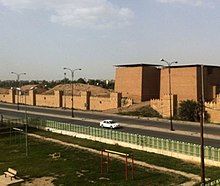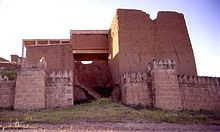Nineveh
![]()
Ninua is a redirect to this article. For the Georgian football player, see Nika Ninua.
![]()
This article is about the ancient Near Eastern city. For other meanings, see Nineveh (disambiguation).
36.366666666743.15Coordinates: 36° 22′ 0″ N, 43° 9′ 0″ E
Nineveh, Akkadian Ninu(w)a (Arabic نينوى, DMG Nīnawā, Aramaic ܢܝܢܘܐ Nīnwē, Hebrew נִינְוֵה 'Nīnəwē, also Nineveh) was a Mesopotamian city in present-day Iraq, on the left bank of the Tigris River, at the mouth of the small river Chosr (also Ḫosr, Khoser, Koussour or Arabic نهر الخوصر, DMG Nahr al-Khosr) within the modern city of Mosul. The oldest settlement remains are located on the ruined hills (tells) of Kujundjik and Nebi Junus. In the 1st millennium BC, the settlement extended to the surrounding area, reaching a total area of 750 hectares. The explored settlement layers date Nineveh from the Ceramic Neolithic to the Islamic period, with its greatest importance in the 7th century BC as the capital of the Assyrian Empire.
Archaeological site
Excavation history
Between 1808 and 1820 Claudius James Rich, resident of the East India Company in Baghdad, was in Mosul four times. While there, Rich investigated the mound of Kuyunjik, of which he produced the first detailed description with plan, which was very important for subsequent excavators.
In 1842 Nineveh was rediscovered and excavated in parts by Paul-Émile Botta. As he found nothing promising in his eyes after three months of work, he turned to Khorsabad. The period of the first British excavations at Tell Kujundjik (1845-1855) was heralded by Austen Henry Layard and C. Rassam ushered in. During the first, highly successful campaign, several Neo-Assyrian temples and palace buildings were discovered.
At the end of the 19th century, the discovery of cuneiform tablets with the "biblical" Flood narrative (fragments of the Gilgamesh epic) by George Smith caused a great stir and gave a boost to further excavations on the tell. This triggered a veritable hunt for the tablets ("tablet hunt"), which was also joined by C. Rassam's brother Hormuzd Rassam. The finds of clay tablets came mainly from the library of Aššurbanipal. In the early 20th century the excavations were continued by the Briton Richard Campbell Thompson. In 1931-32, R. C. Thompson and Max Mallowan laid out a deep cut that reached the layers of Nineveh 1 (now known as the Hassuna period). The stratigraphic sequence of the deep cut:
- Nineveh 5 - painted pottery, early dynastic, 2900-2360 BC.
- Nineveh 4 - Djemdet Nasr period, corresponds to Tepe Gaura X-VIII
- Nineveh 3 - Obed (Obed 3/4)
- Nineveh 2 - Eastern Halaf
- Nineveh 1 - Hassunna
During the fighting of the two world wars, Tell Kujundschik was used as a base camp by Turkish and British military forces because of its strategically favourable location. Nevertheless, the damage caused during the war is estimated by researchers to be less than that caused by Thompson's excavations to archaeology. Overall, little care was taken in the graphic documentation of architectural remains during this controversial era of excavations.
After World War II, Nineveh was quiet for a long time, until the Iraqi Antiquities Administration began to restore palaces and temples in 1965 and carried out several rescue excavations. Vast areas were uncovered again and covered over to protect the reliefs. The government declared the entire area within the city walls an archaeological park and issued a strict ban on construction.
The last excavations to date, between 1987 and the outbreak of the Second Gulf War, were undertaken by an American team led by David Stronach. The Iraqi archaeologists have restored parts of the city wall and some city gates, most recently with the support of the US army.
Destruction by the "Islamic State
In late February 2015, archaeological finds, mostly statues from different periods of the Assyrian empires, were destroyed at the Mosul museum by the Salafist terrorist militia Islamic State (IS). Also, "at the archaeological site (in Nineveh), the fanatics attacked a gatekeeper figure with a pneumatic drill." Markus Hilgert, director of the Museum of the Ancient Near East in Berlin until May 2018, called for a protection program in the process, including training Syrian and Iraqi archaeologists and restorers. A project funded for three years by the German Federal Ministry of Education and Research also aims to "better illuminate the black market in ancient works of art. [...] Because the excavation pieces that the Islamic State does not destroy, it sells."
In April 2016, IS destroyed the Nergal Gate using military equipment. In January 2017, the site, located in the eastern district of Mosul, was recaptured by Iraqi forces.
In 2014, the Nebi Yunus Mosque, which according to long tradition housed the tomb of the prophet Jonah, was blown up by IS forces and the remains of the 7th-century BC military palace below were looted for two years with the help of a network of tunnels. In 2018-19, an archaeological team from the University of Heidelberg, led by Peter A. Miglus and Stefan Maul, conducted new research here with the aim of documenting the destruction caused and gaining new insights into the palace building. The scientific publication of these investigations is currently in preparation.

Taking down of the Winged Bull during the Layard excavation

Reconstruction of the city wall with the Mashki Gate

Reconstruction of the gate dedicated to the god Adad
Reception
Nineveh in the Bible
In the Old Testament of the Bible including the Apocrypha Nineveh is mentioned more often. Nimrod, a great-grandson of Noah, is mentioned as the founder of Nineveh in Genesis 10:11 EU. 2 Kings 19:36 EU names it as the residence of the Assyrian king Sanherib. The book of Nahum contains prophecies of the fall (Nah 2 EU) of Nineveh, which was called a great harlot (Nah 3 EU). The Book of Jonah records the sending of the prophet of the same name to Nineveh, who announced God's judgment to the city, so that the city repented of its evil ways. As a result, God did not do the evil he had threatened them with. In the book of Zephaniah there is a foreign nation's judgment against Nineveh. The downfall of the city is announced:
"Jackdaws and owls will also spend the night on their pillars. They will cry in the windows, and the ravens on the sills. For the cedar is torn down."
- Zephaniah 2:14 LUT
The city becomes the laughing stock of passers-by, who whistle and clap their hands in delight at its destruction.
The prophet Nahum of Elkosch also describes the coming destruction. The city shall go up in flames, the inhabitants perish by the sword, while the queen and the virgins shall be carried away, and the people scattered over the hills. The walls of the palace shall be destroyed by the waters of the diverted river. Like a ripe fig the city shall fall, however secure it may feel.
"5 Behold, I will be upon thee, saith the LORD of hosts; I will lift up the hem of thy garment over thy face, and show thy nakedness unto the nations, and thy shame unto the kingdoms. 6 I will cast filth upon thee, I will defile thee, I will make a spectacle of thee, 7 That all they that see thee shall flee from thee, saying, Nineveh is laid waste; who will have compassion on her? And where shall I seek comfort for thee?"
- Nahum 3:5-7 LUT
In later Old Testament writings, in the Book of Jonah, which was probably written only in Hellenistic times, as well as in the Books of Tobit and Judith, which are by no means older, the memory of Nineveh as the Assyrian capital has been continued. The city now stands as a literary symbol of all the great powers under whose domination Israel was (so in Jonah), or as the capital of the (negatively) idealized great power dominating or threatening Israel (so in Tobit and Judith). That the city has become a literary topos for the threatening great power in the first place is evident in the Book of Jonah as well as in the Book of Judith in the fact that the Nineveh image is linked with elements of other great powers. In the Book of Jonah, elements are incorporated into the Nineveh image that were originally connected with the Persians (one-god faith of the Ninevites; joint decree of the king and his great officials; inclusion of animals in the atonement); in the Book of Judith, Nineveh, the capital of Assyria, is depicted as the residence of Nebuchadnezzar, who was not king of Assyria but of Babylon. At the same time the latter has a field captain with the Persian name of Holofernes. So in the book of Jonah, Nineveh is associated with the elements of two great powers that Israel had to deal with in its history, the Assyrians and the Persians. In the book of Judith Nineveh as a residence is part of a great power picture in which elements of three great powers have entered, the Assyrians, the Babylonians and the Persians.
Nineveh in Classical Antiquity
Xenophon, in the Anabasis (III,4,10-12), described the ruins of Nineveh under the name of Maspila, which he had probably seen himself, but he connects them with the reign of the Medes and the conquest by Cyrus II. Herodotus (I,178) tells of a city of Ninos on the Tigris, after the fall of which the seat of royalty was transferred to Babylon.
Later authors such as Ctesias of Knidos report that Ninos was founded by king Ninos (as Babylon was founded by Belos), but otherwise know little concrete to report. The description of the tomb of Ninos in Diodorus suggests that at this time the whole tell was equated with the ruins of the tomb. Strabo (Geographika 16,2) tells of the city of Ninos, founded by King Ninos, the husband of Semiramis. It was larger than Babylon, and was situated in Aturia, separated from Arbela by the river Lycos. Ninos was destroyed after the defeat of the Medes.
Search within the encyclopedia